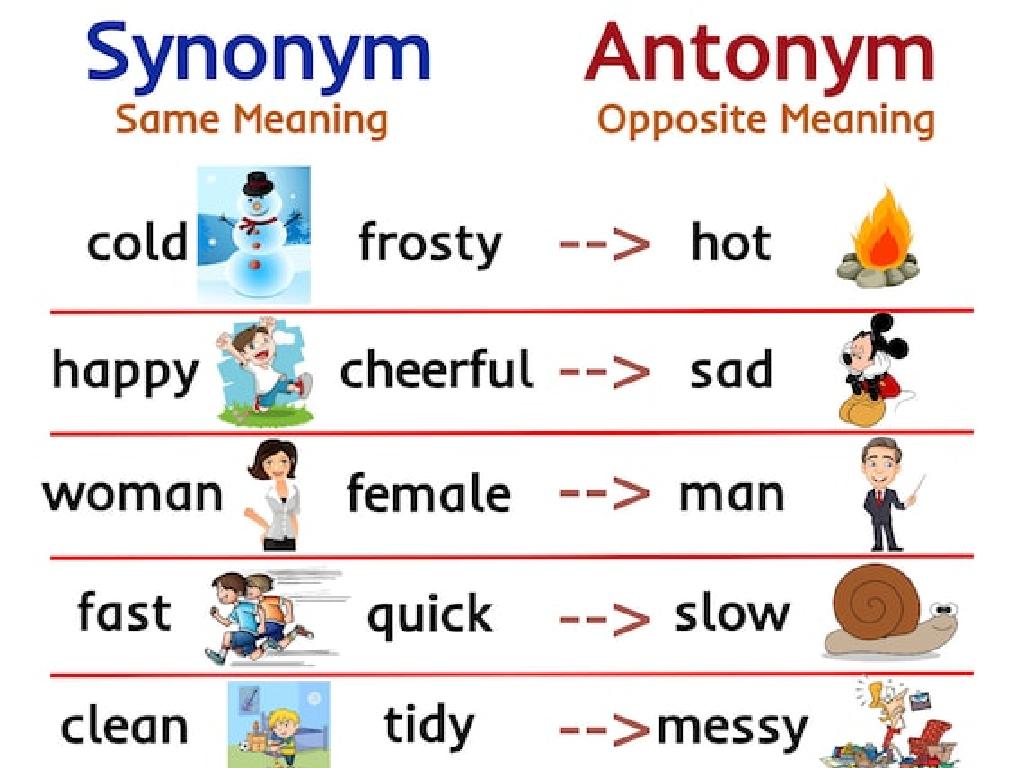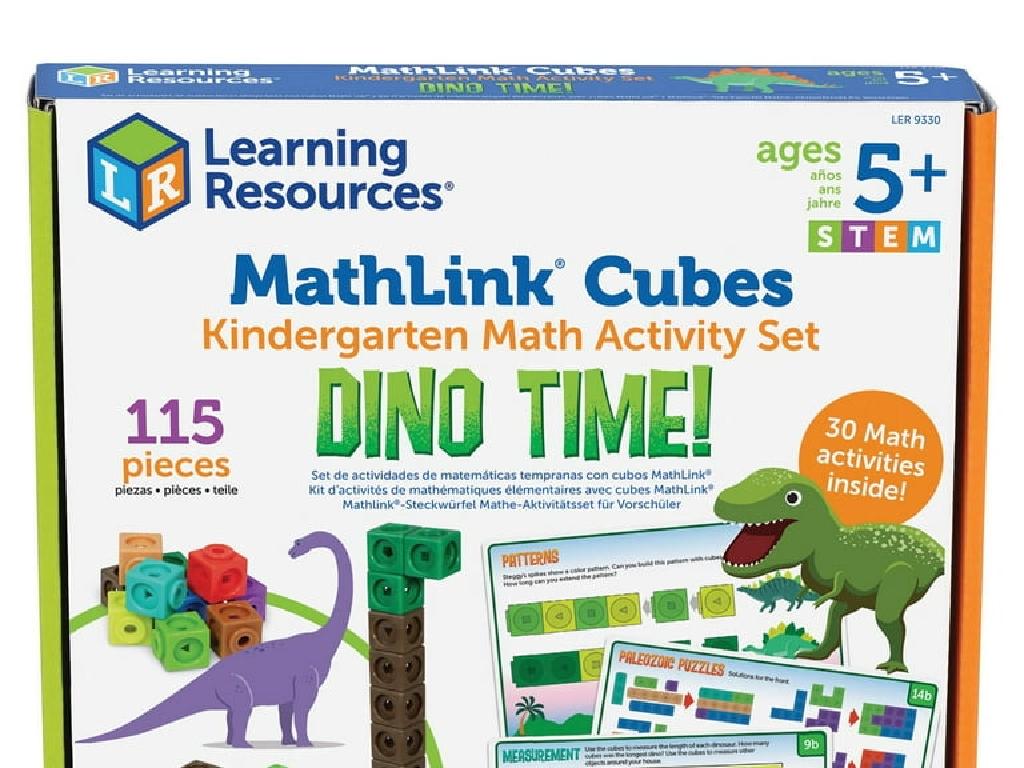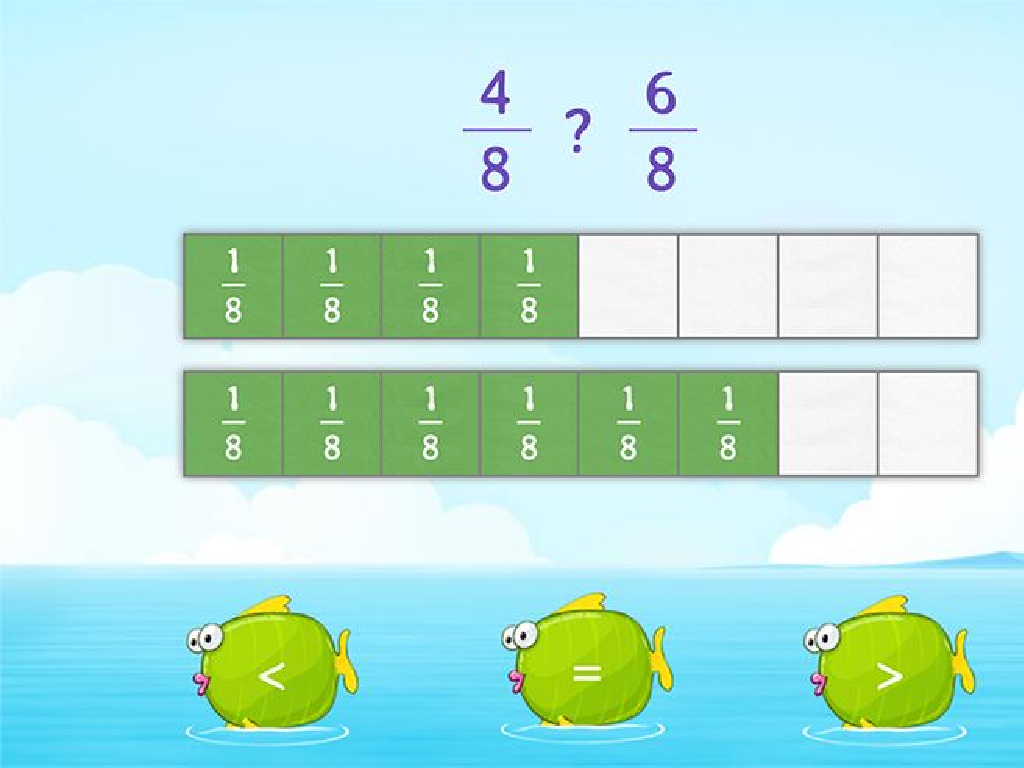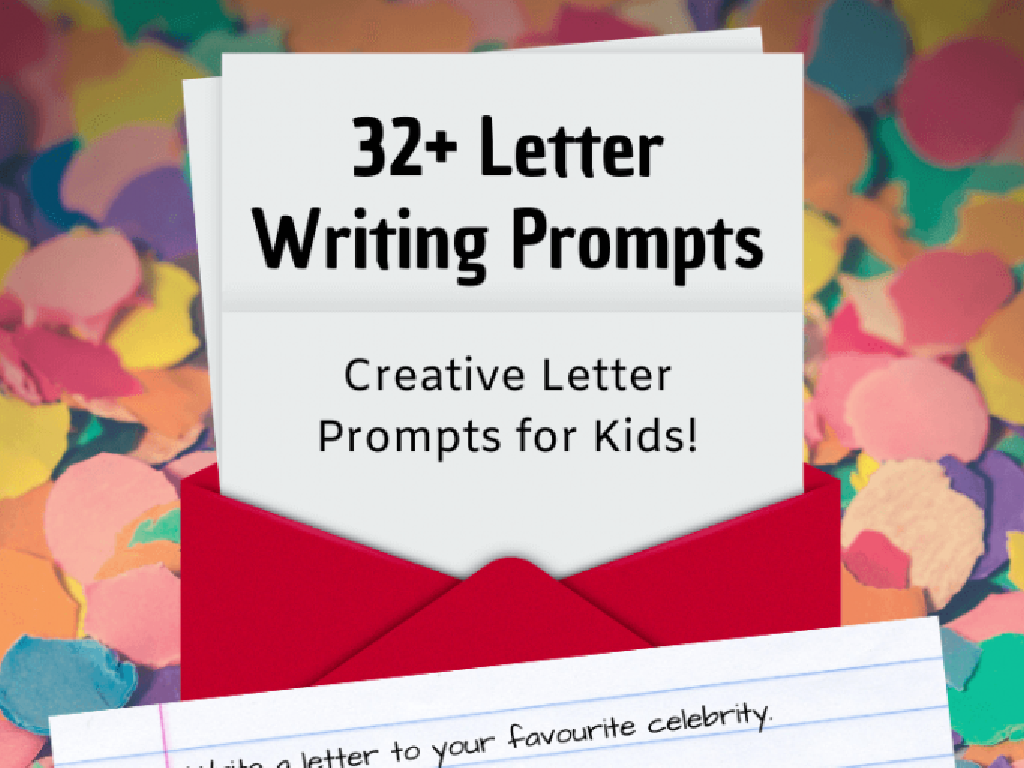Identify Time-Order Words
Subject: Language arts
Grade: Fourth grade
Topic: Linking Words
Please LOG IN to download the presentation. Access is available to registered users only.
View More Content
Today’s Adventure: Time-Order Words!
– Exploring Linking Words
– Time-Order Words Unveiled
– Words that tell us the sequence of events, like ‘first’, ‘next’, ‘then’, ‘finally’.
– The Significance of Time-Order Words
– They help us understand the order in which things happen.
– Examples of Time-Order Words
– ‘First’ we get up, ‘then’ we eat breakfast, ‘next’ we go to school, ‘finally’ we come home.
|
This slide introduces the concept of linking words, with a focus on time-order words, which are a type of linking word. Time-order words are crucial for understanding and conveying the sequence of events in a story or instructions. They help us organize our thoughts and writing in a logical order. Emphasize the importance of these words in helping the reader follow along with the sequence of events. Provide examples and encourage students to think of their own examples of time-order words in their daily routines. This will prepare them for activities where they will use these words to describe sequences in stories or instructions.
Understanding Time-Order Words
– What are time-order words?
– Words that signal the timing of events
– Examples: first, next, then, finally
– ‘First’ indicates the start, ‘finally’ signals the end
– Purpose of time-order words
– They arrange events in a logical order
– Using them in sentences
– ‘First I ate breakfast, then I went to school.’
|
Time-order words are essential for students to understand the sequence of events in a story or instructions. They act as signals that help readers follow the progression of events or steps in a process. By using words like ‘first,’ ‘next,’ ‘then,’ and ‘finally,’ students can clearly describe the order in which things happen. Encourage students to practice using these words by writing their own sentences or short paragraphs that describe a series of events, such as their morning routine or the plot of a story they’ve read. This will help them grasp the concept of chronological order and improve their narrative skills.
Using Time-Order Words in Sentences
– Examples of time-order words
– ‘First’, ‘next’, ‘then’, ‘finally’ are some examples.
– Spot time-order words in sentences
– Find words that tell us ‘when’ things happen.
– Discuss sentence changes
– How does the meaning change if we remove them?
– Understand the importance
– These words help us understand the sequence of events.
|
This slide aims to teach students the role of time-order words in providing clarity and sequence to events in a sentence. Start by showing sentences that use time-order words effectively. Then, have students identify these words in each example. Discuss as a class how the removal of these words can lead to confusion and misunderstand the sequence of events. Emphasize that time-order words are crucial for writing clear and coherent narratives or instructions. Encourage students to think of their own sentences using time-order words and consider how their absence would alter the sentence’s meaning.
Time-Order Words in Stories
– Understanding time-order words
– Words that tell us the sequence of events
– Reading for time-order clues
– Read a story excerpt together in class
– Identifying time-order words
– Find and underline words that show time sequence
– Practice with a paragraph
|
Time-order words are essential for understanding the sequence of events in a story. They help us know when things happen, such as ‘first’, ‘next’, ‘then’, and ‘finally’. During the lesson, read a paragraph from a story aloud and guide students to listen for these keywords that indicate the order of events. Encourage them to spot and underline the time-order words as they follow along. This activity will help them see how authors use these words to structure their writing. It’s a practical exercise that will enhance their reading comprehension and writing skills.
Your Turn: Crafting Stories with Time-Order Words
– Write a short story using time-order words
– Include words like ‘first’, ‘next’, ‘then’, ‘finally’
– Exchange stories with a classmate
– Share what you wrote and listen to their story
– Discuss sequence importance in stories
– How do these words help the story flow?
– Reflect on how time-order words guide the reader
|
This activity slide encourages students to apply their knowledge of time-order words by writing their own short stories. Time-order words are crucial for indicating the sequence of events, which helps readers follow the plot. Students should use words like ‘first’, ‘next’, ‘then’, and ‘finally’ to clearly mark the progression of events. After writing, students will partner up to exchange and read each other’s stories, providing an opportunity to see how their peers use time-order words. In the discussion, emphasize how sequence aids in comprehension and ask students to reflect on how their partner’s use of time-order words affected their understanding of the story.
Class Activity: Time-Order Word Hunt
– Search for time-order words in books
– Record sentences with these words
– Share your findings with the class
– Discuss the use of time-order words
– Why do authors use these words? How do they help the reader?
|
This activity is designed to help students recognize and understand the use of time-order words in writing. Time-order words are important for sequencing events and helping the reader follow the progression of a story or text. Have the students look through their classroom books to find sentences that contain words like ‘first’, ‘next’, ‘then’, ‘finally’, etc. Encourage them to write down the whole sentence to see how the word fits into context. After the hunt, each student will share their sentences, and the class will discuss how these words guide the reader through the events described. As a teacher, prepare to provide examples and guide the discussion to ensure students grasp the concept.
Conclusion & Reflection: Time-Order Words
– Purpose of time-order words
– They help us describe the sequence of events clearly.
– Understanding stories with time-order
– They clarify the order, making stories easier to follow.
– Reflect on using time-order words today
– Think about when you told a story or described your day.
|
As we wrap up, let’s reflect on the importance of time-order words. These words, like ‘first’, ‘next’, ‘then’, and ‘finally’, are crucial for sequencing events in storytelling and writing. They help readers and listeners understand the progression of events and the timeline within a story. Encourage students to think about how these words improve comprehension and make narratives more engaging. Ask them to recall instances from their day where they used time-order words, perhaps when recounting an event or explaining how to do something. This reflection will help solidify their understanding of the concept and its practical use in daily communication.






